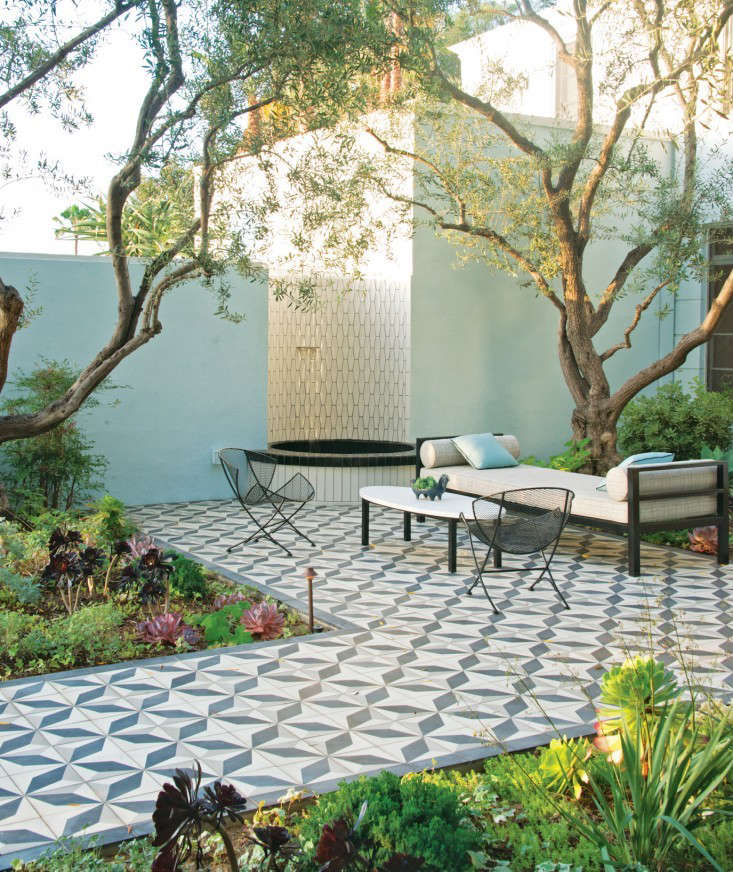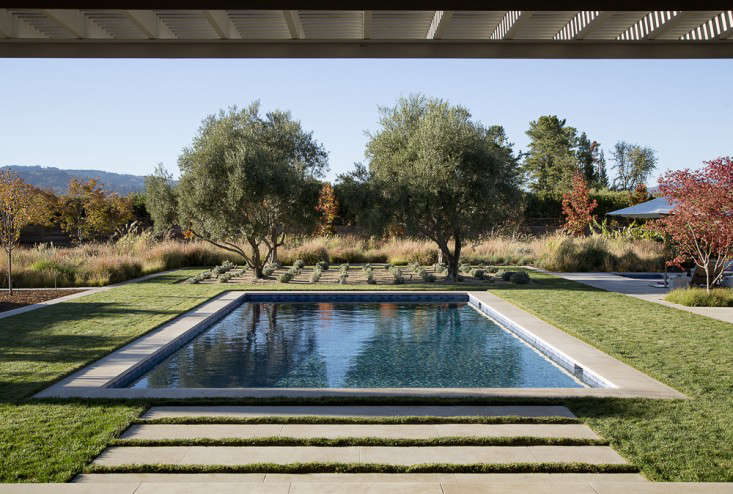California’s great garden designers borrowed nearly every good idea they’ve had from earlier centuries, and yet have managed in a mere hundred years or so to create an original and instantly recognizable style. We have Thomas Church to thank for that.
Church was California’s first great landscape architect, and during the course of the 20th century he gave us outdoor rooms, the kidney swimming pool, and an unshakable belief that our lives should be connected to the landscape.
“Gardens are for people,” Church wrote in his 1955 book with the same title. During a career that spanned four decades, he designed more than 2,000 gardens that capitalized on California’s perfect climate and the same restless urge for wide open spaces that propelled pioneers to cross mountains to get here.
Here are 10 garden ideas to steal from California landscape architect Thomas Church:
Worship Trees

Above: Photograph courtesy of Remodelista Architects and Designers Directory member Andrea Cochran Landscape Architecture. For more of her work, see A Peaceful Retreat in Northern California.
Design a landscape to take advantage of existing trees; they will block wind and provide shade better than any other solution you can devise. “It’s no wonder that when we first think of a garden we think of a tree,” said Church, who considered trees “the greatest single element linking us visually and emotionally with our surroundings.”
Some Trees Have Got to Go
The job of a garden is to lure you outdoors to spend time in natural surroundings. A poorly sited tree–too big for your yard, or blocking a view–is a detriment, Church believed. “Consider pruning before chopping down; perhaps it is possible to both keep the tree and reveal the view it supposedly hides,” he wrote. “On the other hand, some trees have got to go. It’s sad but there is is. … If a tree is choking your house or yard, by all means get rid of it.”
Don’t Block a View

Above: Photograph via RADD member Andrea Cochran Landscape Architecture.
“Distant views of mountains and water, intimate views of hills and woods, views over cities at night, all have an endless fascination for people,” Church wrote. “Put as few obstacles and diverting lines between you and your view if you want it to retain all its drama.”
Borrow Other People’s Views
Above: Photograph by Mathew Millman courtesy of Scott Lewis. For more, see Vineyard Haven: A Napa Valley Garden That Belongs to the Land.
Don’t build a fence you don’t need, Church advised: “Instead, look out at the neighboring property. Someone else is maintaining it and paying the taxes; you’re enjoying it.”
Create Outdoor Rooms

Above: Garden designer Judy Kameon transformed a Southern California courtyard into a “front room” of a 1930s home. For more, see Required Reading: Gardens are for Living by Judy Kameon.
People need more space–but not necessarily indoors. In fact, it is much more palatable to inhabit crammed quarters if you can do some of your living elsewhere. Church’s gardens created spaces to lounge, cook, eat, or entertain outdoors. The idea is to blur boundaries between indoor and outdoor spaces so that home and garden are connected seamlessly.
Native Plants 101
Above: Photograph courtesy of Grow Outdoor Design. For more of this garden, see Designer Visit: Grow Outdoor Design’s Drought Tolerant Garden in Bel Air.
If you’re designing a garden from scratch, Church suggested you look around: what plants are already happily growing in the landscape?
Smooth the Sharp Edges
Above: Rounded edges soften a swimming pool in A Secret Garden. Photograph courtesy of Michael Leva.
“A curved line against a view presents the least irritation” to the eye as you seek a distant view, Church believed. To that end, his gardens had irregularly shaped patches of lawn, kidney-shaped swimming pools, and meandering paths.
The Journey is the Destination

Above: A wide, shady path at the edge of the former Sunset magazine campus gardens designed by Thomas Church. Photograph by Michelle Slatalla.
“Gardens should look good from every angle and have no obvious “beginning” or “end,” Church believed. He designed curved paths to convey a pedestrian leisurely from one area to the next and edged them with garden beds of layered plantings to create mystery and depth.
Style vs. Principle

Above: A Big Sur house on a seaside cliff fits the contours of the landscape. For more, see Architect Visit: The Medieval Mist and Mystery of Big Sur. Photograph by Joe Fletcher courtesy of Fougeron Architecture.
Above: “Style is a matter of taste, design a matter of principle,” Church wrote. It doesn’t matter whether the style of your garden is English cottage, Italian Renaissance, or Noguchi-minimalist. It will look good and serve you well if you design it following four principles: unity, function, simplicity, and scale.
In other words, a garden and house must be interconnected, work together, have no distracting flourishes, and be in proportion to one another.
Pare Down the Palette
Above: A planting scheme of perennials and grasses designed by Missouri-based garden designer Adam Woodruff, who won our 2014 Considered Design Award for Best Professional Landscape.
A simple planting scheme with a limited number of varieties will make maintenance easier, Thomas Church believed. Start with a strong garden design, and you can always go back later and add more plants if you want.

Above: See more of Church’s ideas in Gardens Are For People; $45.95 from Amazon.
For more ideas from our favorite California gardens, see:
- Before & After: A Grande Dame in LA’S Hancock Park.
- Landscape Architect Visit: An Urban Oasis in a Small SF Backyard.
- Outbuilding of the Week: A Salvaged Shed in a Napa Garden.














Have a Question or Comment About This Post?
Join the conversation (1)